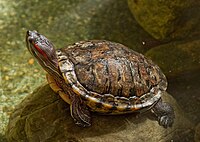
Photo from wikipedia
Harmful algal blooms (HABs) occur nearly annually off the west coast of Florida and can impact both humans and wildlife, resulting in morbidity and increased mortality of marine animals including… Click to show full abstract
Harmful algal blooms (HABs) occur nearly annually off the west coast of Florida and can impact both humans and wildlife, resulting in morbidity and increased mortality of marine animals including sea turtles. The key organism in Florida red tides is the dinoflagellate Karenia brevis that produces a suite of potent neurotoxins referred to as the brevetoxins (PbTx). Despite recent mortality events and rehabilitation efforts, still little is known about how the toxin directly impacts sea turtles, as they are not amenable to experimentation and what is known about toxin levels and distribution comes primarily from post-mortem data. In this study, we utilized the freshwater turtle Trachemys scripta and the diamondback terrapin, Malaclemys terrapin as model organisms to determine the distribution, clearance, and routes of excretion of the most common form of the toxin, brevetoxin-3, in turtles. Turtles were administered toxin via esophageal tube to mimic ingestion (33.48μg/kg PbTx-3, 3×/week for two weeks for a total of 7 doses) or by intratracheal instillation (10.53μg/kg, 3×/week for four weeks for a total of 12 doses) to mimic inhalation. Both oral and intratracheal administration of the toxin produced a suite of behavioral responses symptomatic of brevetoxicosis. The toxin distributed to all organ systems within 1h of administration but was rapidly cleared out over 24-48h, corresponding to a decline in clinical symptoms. Excretion appears to be primarily through conjugation to bile salts. Histopathological study revealed that the frequency of lesions varied within experimental groups with some turtles having no significant lesions at all, while similar lesions were found in a low number of control turtles suggesting another common factor(s) could be responsible. The overall goal of this research is better understand the impacts of brevetoxin on turtles in order to develop better treatment protocols for sea turtles exposed to HABs.
Journal Title: Aquatic toxicology
Year Published: 2017
Link to full text (if available)
Share on Social Media: Sign Up to like & get
recommendations!